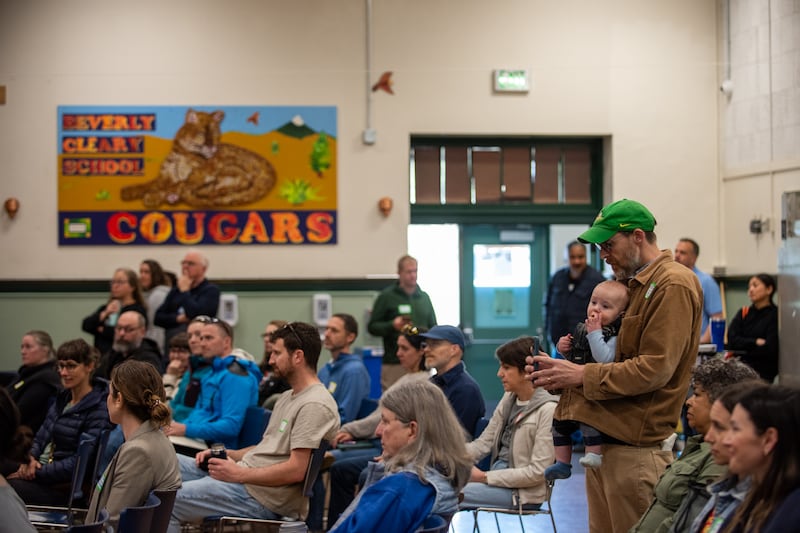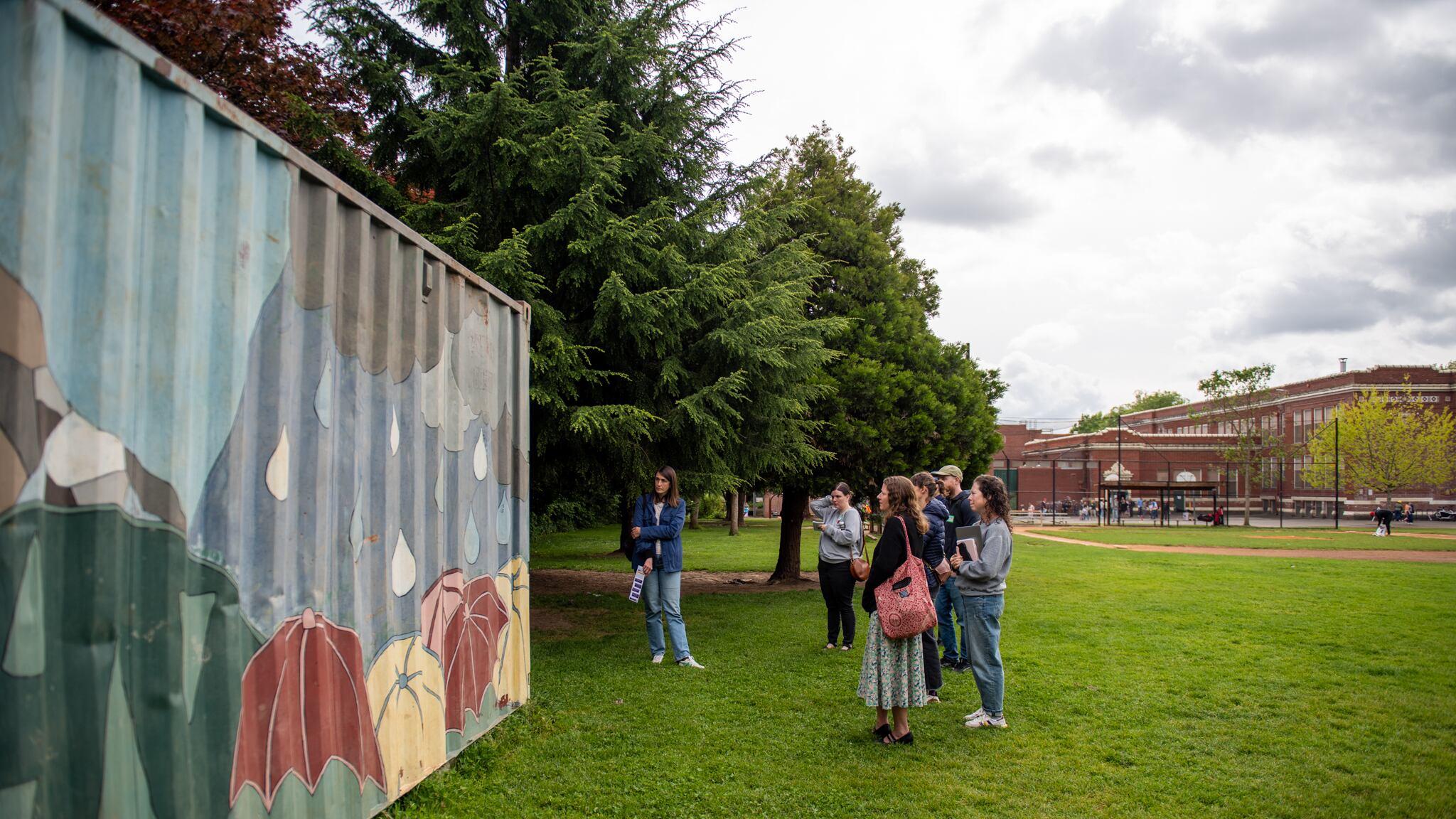A shipping container stands at the corner of Beverly Cleary K-8 School in Northeast Portland, meant to be cracked open if the Cascadia subduction zone earthquake strikes during school hours.
But the box, assembled by the school’s parent safety committee and PTA, contains no supplies meant to tide kids over with, say, food and water. Instead, it’s filled with crowbars, stretchers and shovels to dig bodies out of the rubble.
That’s because Beverly Cleary, like 18 other buildings in Portland Public Schools’ portfolio, is an unreinforced masonry building. Even a moderate quake could lead to a complete collapse of the structure, which, as WW reported six weeks ago, has beams, girders and trusses resting on brick walls (“Shake Shacks,” March 26).
At that time, a small but committed group of parents were regularly urging PPS to come up with a strategy for how it was going to make badly needed seismic upgrades, with little success. No money was earmarked in the $1.83 billion bond for seismic safety, and parents were concerned it would be another eight to 10 years before they could push for money for retrofits.
“It makes me feel like the worst parent in the world. I kiss [my daughter] every single morning when I send her to school, and I think, ‘Please, not today,’” says Beverly Cleary mom Catalina Gonzalez, whose younger daughter still attends the school. “It’s unfair. Kids need to be safe.”
But in the weeks since WW‘s reporting, the rumblings for seismic safety have grown strong enough to shake the School Board. Per Olstad, one of the most vocal parents at Beverly Cleary, developed a group called Safe Structures PPS. That group has garnered about 400 signatures from the community thus far, calling for the district to direct bond money to seismic upgrades. The momentum has persisted in various public forums over the past several weeks, including at a budget committee meeting at Grant High School on April 29, where a number of parents spoke up about seismic hazards.
With the bond measure under increasing scrutiny and its backers conceding to The Oregonian last week that the vote will be narrow, such pressure matters. The result? Parents clamoring for earthquake safety compelled some members of the School Board to redraw the allocation of funds from a bond measure whose ballots are already sitting on Portlanders’ kitchen tables.
On May 2, board members Herman Greene, Julia Brim-Edwards and Gary Hollands debuted a resolution that prioritized seismic upgrades in bond spending. On Tuesday night, it passed with unanimous support from board members.
“Parents asked us for a specific commitment in the upcoming bond to fund improvement at the schools with the highest risk of damage and collapse in an earthquake,” Brim-Edwards says. “[I thank] the parents who made the case that it wasn’t too late to improve the bond package, and helped us craft a resolution for the board’s consideration that meets the moment.”
In its current form, the bond allocates $190 million to deferred maintenance, though there are no specific earmarks for seismic improvements. There could also be an additional $176 million to $208 million committed to elementary and middle school projects if there is spillover from three high school modernizations. A May 3 district memo estimates it would cost about $129.3 million to seismically retrofit only URM at all schools, but that does not include soft costs like design services.
Under the new resolution, seismic upgrades will become “an urgent district priority.” It directs the district to set aside $100 million in bond funds for emergency projects that address “imminent risk,” but notes seismic upgrades should be the next-highest priority.
For parents who’ve worried about the Big One for years, assurance will come from the School Board charging the superintendent to develop a spending plan. Known as the Seismic Risk Reduction Plan, it will identify buildings in need of repair and prioritize them based on objective risk factors and equity considerations. The plan calls for the district to outline a schedule for repairs no later than Sept. 1.
“It finally feels like we’ve moved the needle in the right direction, that this isn’t also just some potential Band-Aid fix, that this is a real chance to make some positive impact on this issue across the entire school district,” says Marie Westom, who has two sons in the elementary grades at Beverly Cleary and is its PTA president.

On May 4, dozens of families, alongside current members of the PPS Board and candidates seeking a seat, gathered in the Beverly Cleary auditorium for a meeting about the seismic risks PPS faces. Time and again, parents spoke about the moral dilemma they faced between keeping their kids in a school system they believe in, while risking their safety.
“A parent’s No. 1 job is to keep their children safe. I think everyone here can agree with that,” Olstad, a father of two, told a widely receptive audience. “We’re here today because we can do some real tangible things to fix these problems.”
Olstad says after the publication of WW‘s seismic cover story, he started getting emails from parents he’d never met across various schools. They all shared one sentiment: They had no idea of the seismic risks. The effort to keep schools safe expanded.
In the past week, Olstad’s gone from skeptical of the bond to a full-blown proponent of it. “I am very excited to see this resolution pass and to get on to the work of passing the bond,” he said at Tuesday’s board meeting.
Tony Morse, campaign manager for Yes for Portland Schools, says he ran out of yard signs to distribute at the May 4 event as parents learned of the resolution.
“I think that this pending board resolution for certain folks is very important,” Morse says. “Any time you have something on the ballot that goes towards an issue of great importance to somebody, that will, I think, spur a certain degree of enthusiasm.”
Questions remain. One attendee asked where the money would come from if PPS determined that Beverly Cleary, or other high-risk seismic schools, should be closed and rebuilt entirely instead of retrofitted. It’s also unclear how much money the district could bank from high school modernizations, especially if federal trade policy adds costs to construction. (To the first question, Morse said the board would determine which projects are prioritized and how much money would come from spillover funds from the modernizations. To the second question, he said, “the only certainty is uncertainty” in relation to tariffs and U.S. trade policy.)
Westom, the PTA president, says the plan by the School Board certainly has some flaws, but the perfect should not be allowed to become the enemy of the good. “We can’t just keep kicking the can down the road,” she says. “Let’s make the best decision we can based on the information we have at the time. And if we have to change things down the road, then we have to do that. But at least we’re working with an end goal in sight.”
Gonzalez is still hung up on some parts of the bond. She says she knows the high schools are prioritized in part to avoid disrupting students’ education with too many renovations, but she says that’s never fully made sense to her. “I’d rather be disrupted than not safe,” she says.
Originally from Chile, a country whose geographic location means earthquakes are frequent and seismic safety is held to a high standard, Gonzalez says she was shocked to learn about the deficiencies in PPS’s buildings. She says she’s thought about enrolling her kids in other schools countless times.
Standing on the pavement overlooking Beverly Cleary’s field after the May 4 event, Gonzalez, who’s advocated for better seismic safety for seven years, said some of her choices to keep her kids in the school building have led her to question her parenting. “I feel like everything that I’m saying doesn’t make sense as a parent,” she said.
But then she turned to look out on the swarms of kids playing on the playground and in the grass.
“I guess this is what a community is, right? I’m very proud of being part of this group and everyone else doing [the seismic advocacy work] because someone has to do it,” she said. “My kids are going to be out of the school when this happens, but I want to know that my future neighbors are going to have a good school to go to. A safe school.”

